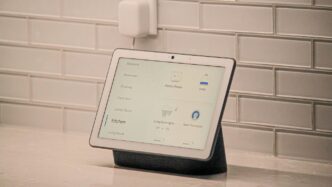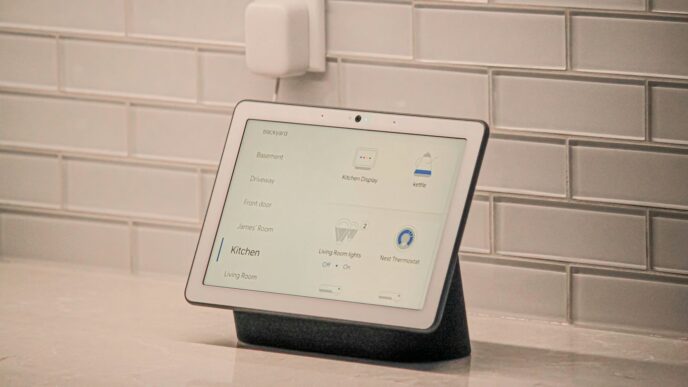Power outages happen, and they can be a real pain. Whether it’s a storm or just a random blip, losing electricity means no lights, no internet, and maybe no heat or AC. That’s where a Base battery backup comes in. It’s like a personal power reserve for your home, ready to kick in when the grid can’t. Think of it as a safety net, giving you peace of mind and keeping things running smoothly, no matter what’s going on outside.
Key Takeaways
- Your Base battery backup system automatically switches to battery power when the grid goes down, usually with a very short delay.
- To make your battery last longer during an outage, identify and turn off high-energy appliances like electric dryers or air conditioners.
- Base offers different battery setups, like single or dual units, to fit your home’s size and how much power you need.
- The Base hub manages power flow, disconnecting from the grid during outages and using rapid charge/discharge to keep your home powered.
- Having a Base battery backup provides reliable power during outages, can help lower your energy bills, and even supports the stability of the local power grid.
Understanding Your Base Battery Backup System
So, you’ve got a Base battery system, and you’re probably wondering how this thing actually works, right? It’s not magic, though sometimes it feels like it when the lights stay on during an outage.
How Your Base Battery Operates
Think of your Base battery like a really smart energy vault for your house. It’s built with Lithium Iron Phosphate (LiFePO₄) cells, which are known for being safer and more stable than the kind you find in your phone. These cells store energy through a neat chemical process. When charging, lithium ions move into the battery’s structure. When your home needs power, these ions move back out, releasing that stored energy. This whole cycle is what keeps your lights on and your fridge running when needed. The system has a few key parts:
- Battery Pack: This is the main unit where all the energy is stored. It’s made up of stacked modules, and inside those are the individual battery cells.
- Inverter: This component is like a translator. It takes the stored Direct Current (DC) power from the battery and turns it into the Alternating Current (AC) power your appliances use. It also does the reverse when charging the battery from the grid.
- Hub: This is the brain of the operation, managing how power flows in and out.
The lifespan of these batteries is typically around 10 to 15 years, which is pretty standard for these kinds of systems. They’re designed to handle different weather conditions, so you can count on them.
Grid Connectivity Explained
Your Base battery isn’t just sitting there waiting for an outage. It’s actually connected to the power grid and plays a role in keeping things stable. Here’s the deal:
- Charging: The battery charges up when electricity is cheaper and less in demand, usually during off-peak hours like midday or late at night. It can pull power from the grid or, if you have solar panels, from them.
- Grid-Balancing: When the grid is working fine and there’s no immediate risk of an outage, your Base battery can actually send some of its stored energy back to the grid. This helps the grid manage demand, especially during busy times. It’s how Base helps keep energy costs lower for everyone.
- Reserve Power: Even when it’s sending power to the grid, the system always keeps a reserve, usually around 20%. This is so it’s ready to protect your home during most common outages.
What Happens During An Outage
This is where the system really shines. When the grid goes down, the Base hub automatically detects the outage. It then quickly disconnects your home from the main power lines. This is a safety feature to prevent the battery from sending power back into the grid while it’s down, which could be dangerous. Once disconnected, the battery takes over, and the inverter starts supplying your home with the stored energy. The transition is usually so fast you won’t even notice the lights flicker. For a typical home using moderate amounts of power, a single Base battery unit can often provide backup for several hours, covering the majority of power outages. If your usage is low, it can last even longer, sometimes for a couple of days.
Maximizing Your Base Battery Backup Duration
So, you’ve got your Base Battery Backup system all set up, ready to keep the lights on when the grid decides to take a break. That’s awesome! But what if an outage lasts longer than you expected, or you just want to make sure your battery lasts as long as possible? It’s not just about having backup power; it’s about making that power last. Think of it like a gas tank in your car – you want to get the most miles out of every fill-up, right? Your battery is the same way.
Identifying Power-Guzzling Appliances
First things first, we need to talk about the energy hogs in your house. These are the appliances that suck up power like a vacuum cleaner on high. If you’ve got a lot of these running during an outage, your battery will drain much faster. Knowing these culprits is the first step to making your backup power last.
Here are some common ones to watch out for:
- Electric Water Heaters: Especially tankless models, these can use a ton of energy to heat water on demand.
- Air Conditioners: Keeping your whole house cool is a big job for any power source.
- Electric Dryers and Washing Machines: Running these, especially at the same time, can really put a strain on your battery.
- Hot Tubs/Jacuzzis: Heating and circulating water in these is a major energy draw.
- Conventional Electric Heaters: Whole-home electric heating systems, the kind that use resistance to generate heat, are big power users.
If you can identify these before an outage hits, you’ll be way ahead of the game. It’s like knowing which roads to avoid during rush hour.
Strategies to Extend Battery Life
Okay, so you know what the big energy users are. Now, what can you actually do about it when the power goes out? It’s all about making smart choices with your energy use.
- Prioritize Essential Loads: Think about what you really need. Lights in key areas, your fridge, maybe a fan. Focus on keeping those running.
- Limit High-Draw Activities: This is where those power-guzzlers come in. If you can, hold off on doing laundry, running the dishwasher, or taking long, hot showers. Maybe use a cooler wash cycle or just air dry clothes if you can.
- Adjust Thermostat Settings: If your AC or heater is running, try setting the thermostat a few degrees higher in the summer or lower in the winter. Every little bit helps.
- Unplug or Turn Off Unused Devices: Even electronics that are off can draw a small amount of power (called "phantom load"). If you’re not using it, unplug it or turn off the breaker for that circuit.
These aren’t always easy choices, but they make a real difference in how long your battery can keep your home powered.
Pre-Outage Preparation Tips
Being ready before an outage strikes is key. It’s much easier to manage your power usage when you’re not in the middle of a blackout.
- Make a List: Before you even have an outage, walk through your home and identify those big energy users. Write them down somewhere accessible – maybe on the fridge or in your phone.
- Communicate with Your Household: Make sure everyone living with you knows which appliances are the big drains and what to do during an outage. Get everyone on the same page.
- Familiarize Yourself with Your Breaker Box: Know which breakers control which appliances. This makes it super easy to shut off power-guzzlers quickly if needed.
- Check Your Battery Status: Use the Base app to see your battery’s current charge level. The fuller it is, the longer it will last.
By taking these simple steps, you’re not just hoping for the best; you’re actively preparing to get the most out of your Base Battery Backup system when you need it most.
Base Battery Backup Configurations
When you’re thinking about getting a Base battery backup, one of the first things you’ll consider is how many units you need. It’s not a one-size-fits-all situation, and the right setup really depends on your home and how you use electricity.
Single Unit System Benefits
A single Base battery unit is a great starting point for many homes. It’s designed to handle the essentials, keeping your lights on, refrigerator running, and maybe even your internet up during a power outage. This is often enough for folks who want basic protection without a huge upfront investment. It’s a straightforward way to get peace of mind.
Dual Unit System Advantages
Now, if you have a larger home, a lot of power-hungry appliances, or you just want more security, a dual-unit system might be the way to go. Think of it as doubling your backup power. This setup can keep more of your home running, including things like your HVAC system or even an electric vehicle charger for a longer period. It’s a more robust solution for those who need more juice.
Choosing The Right Configuration For Your Home
So, how do you pick? First, take a good look at your electricity bill and think about what you absolutely can’t live without during an outage. Are we talking just the fridge and a few lights, or do you need to run your whole house? We can help you figure this out. It’s also worth considering future needs. Maybe you plan on getting an electric car soon, or you’re thinking about adding more appliances. Making the right choice now means you won’t have to upgrade later.
Here’s a quick look at what might influence your decision:
- Home Size: Larger homes generally need more power.
- Appliance Load: Do you have a lot of high-wattage devices like electric stoves, dryers, or hot tubs?
- Occupancy: More people in the house often means more devices running.
- Desired Comfort Level: How much of your normal life do you want to maintain during an outage?
We can walk you through the specifics to make sure your Base battery backup is perfectly suited for your household’s unique needs.
The Technology Behind Base Battery Backup
How The Hub Manages Power Flow
The heart of your Base battery system is its smart hub. Think of it as the brain, constantly monitoring energy flow. It decides when to store power from the grid or solar panels, and when to send that stored energy back to your home. This happens automatically, so you don’t have to lift a finger. The hub uses sophisticated software to make these decisions in real-time, aiming to keep your lights on and your appliances running without interruption. It’s all about making sure the right energy gets to the right place at the right time.
Rapid Charge and Discharge Capabilities
When the grid goes down, speed matters. Your Base battery is designed to switch over to backup power almost instantly. It can also take in energy quickly when it’s available. This rapid charge and discharge capability is thanks to the advanced lithium iron phosphate (LiFePO₄) cells used. These aren’t your typical phone batteries; they’re built for stability and performance. This means the battery can handle sudden demands for power, like when your air conditioner kicks on, without missing a beat. It’s also efficient at soaking up energy when the grid is stable or when your solar panels are producing a lot.
Ensuring System Longevity and Protection
Base batteries are built to last and to protect themselves. They use LiFePO₄ technology, which is known for being safer and more stable than other lithium-ion types. This reduces the risk of overheating. Plus, the system has built-in safety features. If the battery senses an overload or a fault, it has a smart restart sequence. It will try to reset itself a few times. If the problem continues, it will shut down to prevent damage. This protects both the battery and your home’s electrical system. The system is also designed to handle various weather conditions, making it a reliable choice for long-term backup power.
Benefits Of A Base Battery Backup
Having a Base battery backup system for your home really does bring a lot of good things to the table, especially when the power decides to take a vacation. It’s not just about having lights on during an outage, though that’s a big part of it. Think about the peace of mind knowing your fridge won’t spoil its contents or your internet will stay on so you can keep working.
Affordable Home Energy Solutions
One of the biggest hurdles for many people looking into battery backup is the upfront cost. Buying a whole-home generator or a complex solar-battery setup can easily run into tens of thousands of dollars. That’s a huge chunk of change. Base flips this model. Instead of you buying the equipment, they own and manage the system. You pay a one-time installation fee and a monthly membership, which is way more manageable for most budgets. This approach means you get the benefits of backup power without the massive financial burden. Plus, because Base operates the system and earns revenue from the grid, they can offer electricity rates that are consistently lower than what you’d find on the open market. It’s a smart way to get reliable power and save money.
Reliable Power During Grid Failures
When the grid goes down, your Base battery kicks in automatically. It’s designed to power your home without you having to do anything. For typical usage, a Base system can keep your lights on and appliances running for up to 30 hours, which covers about 97% of all power outages. If you’re mindful of your energy use, like turning down the thermostat or avoiding the oven, that backup time can stretch to two, three, or even four days. This level of reliability is a game-changer, especially if you live in an area prone to storms or other disruptions. It means your daily life doesn’t have to come to a screeching halt just because the power lines are down.
Supporting Grid Stability And Lower Rates
This is where Base gets really interesting. Your battery isn’t just sitting there waiting for an outage. It also plays a role in stabilizing the electrical grid. Base uses the battery to help balance supply and demand on the grid, which is a service that grid operators pay for. This income stream is what allows Base to offer you those lower electricity rates. So, by having a Base system, you’re not only securing your own home’s power but also contributing to a more stable and efficient energy grid for everyone. It’s a win-win situation: you get affordable, reliable backup power, and the grid benefits from better management. It’s a pretty neat way to make your home energy system work harder for you and the community.
Navigating Outage Scenarios With Base
Automatic Transition To Battery Power
When the power grid decides to take a break, your Base battery system kicks in. It’s pretty neat, actually. The system automatically disconnects your home from the main grid. This happens in a flash, usually within half a second. You might not even notice it, but that’s the moment your home starts running on battery power. This quick switch means your lights stay on, your fridge keeps humming, and your internet modem doesn’t have to reboot.
Understanding Battery Restarts
Sometimes, if you’re running a lot of high-energy appliances all at once – think electric heaters or maybe a hot tub – your battery might get a little overwhelmed. It’s designed to protect itself from draining too fast. When this happens, it’ll shut itself off. Don’t panic, though. The system is smart and will try to restart automatically three times. It’s basically giving you a heads-up to maybe turn off a few things.
Manual Restart Procedures
If those three automatic restarts don’t do the trick, or if you’ve managed to reduce your power usage and are ready to get things back online, you can do a manual restart. This is super easy to do right from your Base app. Just open it up, find the restart option, and follow the prompts. It’s a good idea to check your app to see how much charge you have left and what your estimated backup time is before you try restarting, just so you know what to expect.
Wrapping Up: Peace of Mind When the Lights Go Out
So, there you have it. A Base battery backup system is more than just a piece of tech; it’s about keeping your household running smoothly when the grid decides to take a break. By understanding how your system works, from its smart grid-balancing tricks to how to manage those power-hungry appliances, you’re setting yourself up for success. It’s about having that reliable power source ready to go, giving you one less thing to worry about when the unexpected happens. With Base, you’re not just getting backup power; you’re getting a simpler, more dependable way to power your home.














